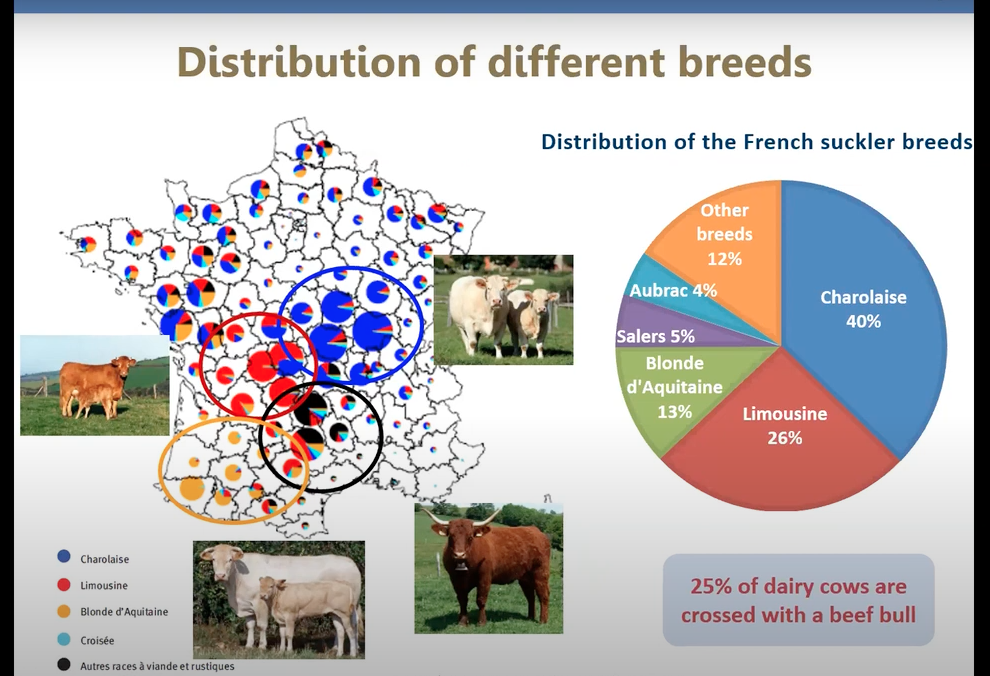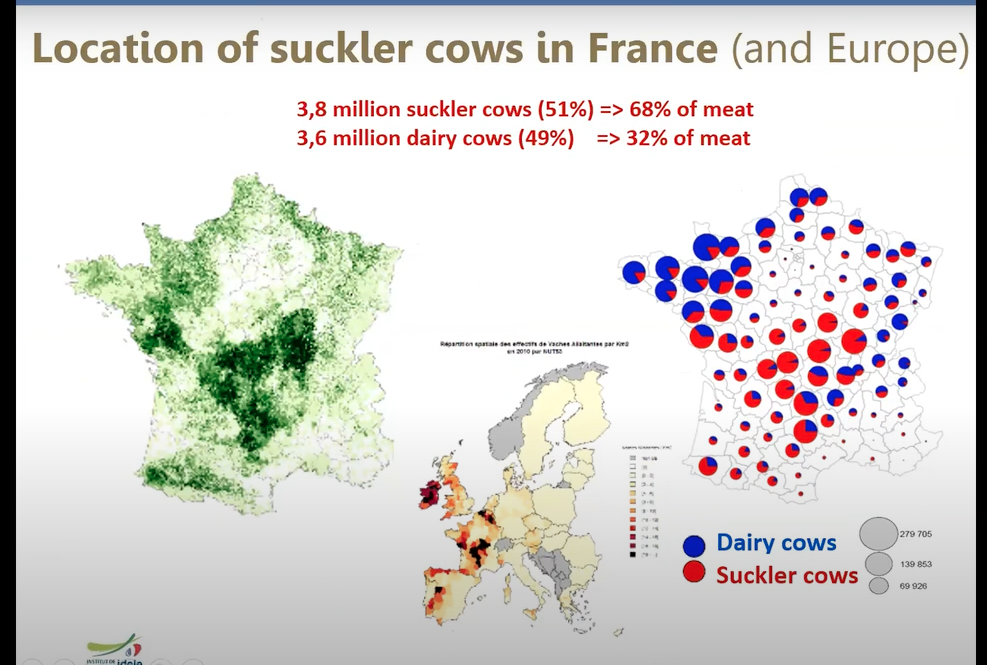



The French R&D framework for beef production
Highly ranked for its integration and strength, France has one of the best frameworks for beef research and development in Europe. Well-functioning systems connect people and knowledge, and help farmers tackle top-of-mind challenges, both current and future, writes Melanie Epp for The Beef Site.André De Gall, livestock expert from the Institut de l’Elevage, shared what makes the French system so strong at a recent Beef Innovation Network Europe meeting, Sustainability of European Beef Farming: Challenges and Solutions.
French beef production: An overview
Although beef production is widespread throughout France, it is most heavily concentrated in the mountainous region in the centre of the country where it's most suitable to raise livestock on forage crops. Most of France’s dairy production takes place in the west of the country where approximately 25 percent of dairy cows are crossed with beef bulls to add value to overall production. Farmers send weanlings to Italy and Spain, but mainly to Italy.

France produces 3.8 million suckler cows, and 3.6 million dairy cows each year. Preferred breeds include Charolais (40 percent), Limousin (26 percent), Blonde d’Aquitaine (13 percent), Salers (5 percent) and Aubrey (4 percent).

France offers huge diversity in terms of forage production. Characterized by its soil and climate, French beef farmers make use of the country’s diverse landscape. Systems range from 100 percent grassland to forage crop systems.
In terms of distribution, the majority of beef production, especially cow-calf operations, is situated in the centre of France. Western operations are predominantly cow-calf and young bull finishers with on-farm fattening systems.
Research and development in France
France has a complex, but integrated research and development system that includes both top-down and bottom-up institutions. The publicly-funded, French National Research Institute for Agriculture, INRAE, for example, is managed by the ministry of agriculture. The Institut de l’Elevage (Idele), for which De Gall works, is a non-profit, non-governmental organization appointed by the French ministry of agriculture. The organization acts as a knowledge transfer hub between basic public research and farmers. Both are considered top-down institutions.
Bottom up institutions include Réseau CIVAM Campagnes Vivantes, La Coopération Agricole, France Conseil Elevage, as well as agriculture and territories chambers of agriculture.These organizations gain significance as they recognize and mobilize the skills and knowledge farmers hold, said De Gall.
From farm to fork, the French framework utilizes a variety of research tools, including experimental farms and meat quality labs. The framework also includes a commercial farms network and a modeling format, which gathers information for central database. Information gathered under this framework allows experts to make recommendations and offers farmers key performance indicators, benchmarks and targets, decision making tools and expertise.
The commercial farm network, for instance, consists of 370 beef farms, 55 local advisors with chambers of agriculture, and seven regional coordinators. Managed by the Idele and the chambers of agriculture, the framework works with the same farms for at least five years. The farms represent the top 25 percent of beef farms in the country, a fact that was criticized by one conference attendee, who said smaller farmers should be represented as well.
In order to ensure consistency, the network has used the same research methodology for 40 years. Recently, though, it added new areas of focus, such as energy, the sector’s carbon footprint, and feed and protein autonomy. Because they use the same methodology, it is easier to make comparisons and evaluations over the long term.
The network also collects farm data related to technical aspects of forage, feeding and fertilization. It logs economic performance, including details on income, subsidies and bank loans, and tracks environmental data, such as nitrogen balance and carbon footprint. French livestock farmers access the collected data, including cost of production and management practices by area, via the Idele website.
France’s research and development framework also includes seven experimental farms, strategically located in regions with prominent production.
Another three experimental farms exist under the public research umbrella. On these farms, researchers test prototypes of innovations. For instance, they use weigher troughs to evaluate feed efficiency. They use echograph technology to assess fat thickness and marbling, and they use green feed and laser guns to calculate methane emissions.
Emissions research is important, said De Gall, as it’s a pressing issue at the moment.
INRAE and Idele also have a partnership unit, a technical mixed unit for suckler systems that was designed with the aim to evaluate farm management techniques that address environmental and productive performance. The research facility plays an important role in bringing together the two arms of research, said De Gall. The focus of the research at this institute is new forage resources, livestock efficiency between species, and use of new technology at the farm level.
Located in Villers Bocage in Normandy, France also has a meat quality lab. The lab is managed by Idele. There, researchers conduct nutritional analyses on feed components, such as lipids, proteins, moisture and collagen, and specific components, such as iron, zinc, selenium shear strength and fatty acid profiles. They also conduct sensory analyses, including the consumer appreciation of products and willingness to pay.
The lab also conducts microbiological analyses and examine pathogens by PCR and challenge tests. Finally, they work with companies and farms to conduct sampling and follow up on studies.
The French research framework includes European projects as well. The beef sector is part of the Beef Carbon project that is working to evaluate the viability of low carbon systems. It is participating in the SustainBeef project, which is assessing the sustainability of beef systems and competition between feed and food.
In another project, Gentore, researchers appraise the resilience and efficiency of dairy and beef herds. There’s a carbon farming project that looks at low carbon systems and carbon credits - it’s looking into climate neutral farms - and a project that aims to assess and authenticate the quality of beef products.
Previous research has resulted in support tools for decision making. COUPROD, for instance, evaluates the cost of production and has already conducted 8,000 audits. CAP’2ER evaluates carbon and environmental criteria and has conducted 7,000 audits. Research has resulted in decision-tools that help improve animal welfare (BoviWell), stunning at slaughter (CET’automatique), and feed and protein autonomy (AutoSysel).
The overall goal to create an efficient and resilient beef sector has been successful. France has a strong and well integrated research system that ranks high amongst its European neighbors. But De Gall said there’s still room for improvement, pointing to Ireland as an example of what could be. Ireland is the only country that ranked higher in terms of integration and strength.
“In France, we are more fragmented, but we try to have cooperation between us,” De Gall concluded.


